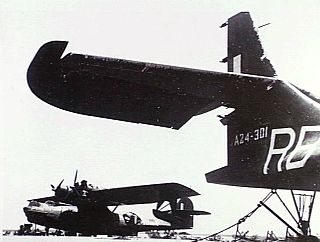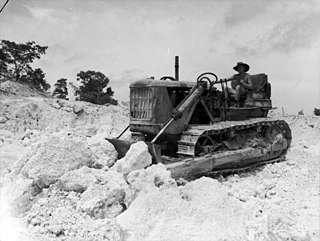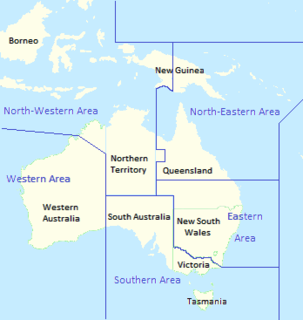
The Australian First Tactical Air Force was formed on 25 October 1944 by the Royal Australian Air Force (RAAF). Its purpose was to provide a mobile force of fighter and ground attack aircraft that could support Allied army and naval units fighting the Empire of Japan in the South West Pacific Area. One of several Allied tactical air forces formed during World War II, it evolved from the RAAF's No. 10 Operational Group, established a year earlier. Following action in the assaults on Aitape and Noemfoor, the group was renamed the First Tactical Air Force to better reflect its size and role. It was beset with morale and leadership issues in early 1945, but recovered to take part in the battles of Tarakan, North Borneo, and Balikpapan. Reaching its peak strength of over 25,000 personnel in July 1945, No. 1 TAF's squadrons operated such aircraft as the P-40 Kittyhawk, Supermarine Spitfire, Bristol Beaufighter, and B-24 Liberator. The formation remained active following the end of hostilities in the Pacific until it was disbanded on 24 July 1946.

The Battle of Tarakan was the first stage in the Borneo campaign of 1945. It began with an amphibious landing by Allied forces on 1 May, code-named Operation Oboe One; the Allied ground forces were drawn mainly from the Australian 26th Brigade, but included a small element of Netherlands East Indies personnel. The main objective of the landing was capture of the island's airfield. While the battle ended with success for the Allied forces over the Japanese defenders, this victory is generally regarded as having not justified its costs. The airfield was so heavily damaged that it ultimately could not be repaired in time to make it operational for other phases of the Allied campaign in Borneo.

No. 16 Air Observation Post Flight was a Royal Australian Air Force (RAAF) unit that saw action in World War II supporting Australian Army operations. It was formed in October 1944 and disbanded in June 1947. The flight was reestablished in September 1958, and was disbanded again in December 1960, when its responsibilities were transferred to a joint Army-RAAF unit.

No. 12 Squadron was a Royal Australian Air Force (RAAF) general purpose, bomber and transport squadron. The squadron was formed in 1939 and saw combat in the South West Pacific theatre of World War II. From 1941 to 1943, it mainly conducted maritime patrols off northern Australia. The squadron was based at Merauke in western New Guinea from November 1943 to July 1944, when it was withdrawn from operations. After being re-equipped, it operated as a heavy bomber unit from February 1945 until the end of the war. The squadron continued in this role until it was redesignated No. 1 Squadron RAAF in February 1948. The squadron was reformed in 1973 to operate transport helicopters but was again disbanded in 1989.

No. 93 Squadron was a Royal Australian Air Force fighter squadron that operated during World War II. It was formed in January 1945 and disbanded in August 1946. Due to delays in bringing operational airfields into service, the squadron saw little combat before the end of the war.

No. 81 Wing is responsible for operating the McDonnell Douglas F/A-18 Hornet multi-role fighters of the Royal Australian Air Force (RAAF). Headquartered at RAAF Base Williamtown, New South Wales, the wing comprises three combat units, Nos. 3 and 77 Squadrons based at Williamtown and No. 75 Squadron at RAAF Base Tindal, Northern Territory, as well as an operational conversion unit at Williamtown. No. 81 Wing headquarters oversees squadron training in air-to-air and air-to-ground tactics, and support for the Australian Army and Royal Australian Navy. Tasked with offensive and defensive counter-air operations, the Hornets have been deployed to Diego Garcia in 2001–02, when they provided local air defence, to Iraq in 2003, when they saw action flying fighter escort and close air support missions in concert with Coalition forces, and to the Middle East in 2015–16, when they undertook strike operations during the military intervention against ISIL. They have also been employed to patrol high-profile events in Australia, including the Commonwealth Games and visits by foreign dignitaries.

No. 82 Wing is the strike and reconnaissance wing of the Royal Australian Air Force (RAAF). It is headquartered at RAAF Base Amberley, Queensland. Coming under the control of Air Combat Group, the wing operates F/A-18F Super Hornet multirole fighters and Pilatus PC-9 forward air control aircraft. Its units include Nos. 1 and 6 Squadrons, operating the Super Hornet, and No. 4 Squadron, operating the PC-9.

No. 114 Mobile Control and Reporting Unit is a Royal Australian Air Force (RAAF) radar surveillance and air defence unit. Located at RAAF Base Darwin, Northern Territory, it is controlled by No. 41 Wing, under Surveillance and Response Group. Its role is to "prepare for, conduct and sustain effective deployable Air Surveillance and Air Battle Management in the Unit's designated area of responsibility". The unit was formed during World War II, and deployed in the South West Pacific. Since the war it has seen service in the Malayan Emergency, the Konfrontasi between Indonesia and Malaysia in the mid-1960s, and the War in Afghanistan.

No. 457 Squadron was a Royal Australian Air Force (RAAF) fighter squadron of World War II. Equipped with Supermarine Spitfire fighters, it was formed in England during June 1941 under Article XV of the Empire Air Training Scheme. The squadron was transferred to Australia in June 1942 and saw combat in the South West Pacific Area before being disbanded in November 1945.

No. 78 Squadron was a Royal Australian Air Force (RAAF) fighter squadron of World War II. It was formed in July 1943 as part of expansion of the RAAF's fighter force, and was assigned to mobile striking forces for the duration of the war.

No. 80 Squadron was a Royal Australian Air Force (RAAF) fighter squadron that operated during World War II. The squadron was formed in September 1943 and was disbanded in July 1946 after seeing action in the South West Pacific Theatre of the war.
No. 11 Group was a Royal Australian Air Force (RAAF) group formed at Morotai in the last weeks of World War II to command the RAAF's garrison units in the region. The group was established at the end of July 1945, but was not yet fully active when the war ended on 14 August. It remained active at Morotai until being disbanded at the end of March 1946.
No. 1 Wing was an Australian Flying Corps (AFC) and Royal Australian Air Force (RAAF) wing active during World War I and World War II. The wing was established on 1 September 1917 as the 1st Training Wing and commanded the AFC's pilot training squadrons in England until April 1919, when it was disbanded. It was reformed on 7 October 1942 as a fighter unit comprising two Australian and one British flying squadrons equipped with Supermarine Spitfire aircraft, and a mobile fighter sector headquarters. The wing provided air defence to Darwin and several other key Allied bases in northern Australia until the end of the war, and was again disbanded in October 1945.

No. 80 Wing was a Royal Australian Air Force (RAAF) wing of World War II. The unit was formed on 15 May 1944 and eventually comprised three squadrons equipped with Spitfire fighter aircraft. The wing's headquarters was absorbed into the newly formed No. 11 Group on 30 July 1945.

No. 77 Wing was a Royal Australian Air Force (RAAF) wing of World War II. It formed part of No. 10 Operational Group at its establishment in November 1943, when it comprised three squadrons equipped with Vultee Vengeance dive bombers. No. 77 Wing commenced operations in early 1944, flying out of Nadzab, Papua New Guinea. Soon afterwards, however, the Vengeance units were withdrawn from combat and replaced with squadrons flying Douglas Bostons, Bristol Beaufighters and Bristol Beauforts. The wing saw action in the assaults on Noemfoor, Tarakan, and North Borneo, by which time it was an all-Beaufighter formation made up of Nos. 22, 30 and 31 Squadrons. It was to have taken part in the Battle of Balikpapan in June 1945, but unsuitable landing grounds meant that the Beaufighter units were withdrawn to Morotai, sitting out the remainder of the war before returning to Australia, where they disbanded, along with the wing headquarters, in 1946.

No. 79 Wing was a Royal Australian Air Force (RAAF) wing of World War II. It was formed in December 1943 at Batchelor, Northern Territory, as part of North-Western Area Command. Led by Group Captain Charles Eaton, the wing comprised four squadrons on its establishment, flying Beaufort and B-25 Mitchell bombers and Beaufighter heavy fighters. No. 79 Wing took part in the New Guinea and North-Western Area Campaigns during 1944–45, eventually transferring to Balikpapan in the Dutch East Indies as the Allies advanced northward. By the end of the Pacific War, the wing was attached to the Australian First Tactical Air Force and was made up of Nos. 2 and 18 Squadrons, both flying Mitchells. The latter transferred to the Netherlands Air Force in late 1945, while the former returned to Australia where it disbanded the following year. No. 79 Headquarters itself disbanded in October 1945, soon after the end of hostilities.

No. 76 Wing was a Royal Australian Air Force (RAAF) wing that operated during World War II. Initially based in Far North Queensland, its headquarters transferred to Darwin, Northern Territory, in September 1944 to take control of three PBY Catalina units: Nos. 20, 42, and 43 Squadrons. The prime task of these squadrons was minelaying in the South West Pacific theatre, and they conducted these operations as far afield as Java, Borneo, the Philippines, and China. As well as minelaying, No. 76 Wing's Catalinas flew bombing, patrol, and transport missions, and dropped millions of propaganda leaflets in the closing months of the war. The wing headquarters disbanded in November 1945.

RAAF Command was the main operational arm of the Royal Australian Air Force (RAAF) during World War II. The command was formed in September 1942 and by April 1943 comprised 27 squadrons, including units from the Netherlands, the United Kingdom and the United States, as well as Australia. Coming under the operational authority of Allied Air Forces Headquarters in the South West Pacific Area, RAAF Command exercised control of its units through geographically based area commands in Australia and, later, New Guinea, as well as large mobile formations including the Australian First Tactical Air Force. The command reached a strength of 41 squadrons in October 1944. From the time of its establishment, until its disbandment in September 1945, it was led by Air Vice Marshal Bill Bostock.

No. 5 Airfield Construction Squadron (5ACS) was a Royal Australian Air Force (RAAF) construction squadron. The unit was first formed in July 1942 and served in the New Guinea Campaign and Borneo Campaign during World War II. The squadron was one of only a few RAAF airfield construction units to be retained at the end of the war, and formed part of Australia's contribution to the occupation of Japan from 1945 until it was disbanded in June 1949. 5ACS was re-raised in August 1951 and worked on several RAAF airfields in Australia. It also provided small detachments of engineers to support RAAF deployments to South Vietnam and Thailand during the Vietnam War. The squadron was the RAAF's only airfield construction unit from 1961 onward, and was disbanded in December 1974.

North-Western Area Command was one of several geographically based commands raised by the Royal Australian Air Force (RAAF) during World War II. Its wartime sphere of operations included the Northern Territory, adjacent portions of Queensland and Western Australia, and the Dutch East Indies. The command was formed in January 1942, following the outbreak of the Pacific War, from the western part of Northern Area Command, which had covered all of northern Australia and Papua. Headquartered at Darwin, North-Western Area Command was initially responsible for air defence, aerial reconnaissance and protection of the sea lanes within its boundaries.



















